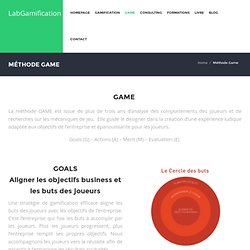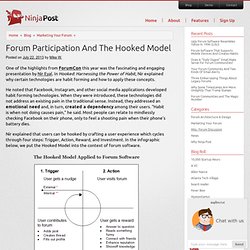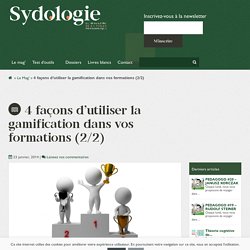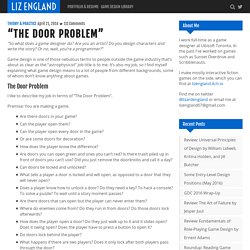

Gaming, Opportunity and Motive. Positive & Negative - Reinforcement & Punishment - TLG. A few gamification tips - Gamified UK Blog. 4 More Insights Revealed by the Gamification Spect... Welcome back for another deeper exploration of the gamification spectrum.

In my previous post, we described 3 patterns in the operational properties of gamification tools. However, the gamification spectrum is far more useful that just that. So this time we will show you 4 more insights we can glean from this spectrum. Again, since the content of this post requires a deep understanding of the previous posts on the gamification spectrum, I recommend revisiting the following posts if you miss any of them: Now, let’s start where we left off last time. Pattern 4: Ideal Visibility and Scope of Feedback Although gamified apps (e.g.
However, as we move to the right of the spectrum, the metrics become less biased and less susceptible to gaming. Insight: Points and badges are biased in favor of long-time players, so they are not really a fair comparison of people’s skills (or abilities). Pattern 5: Value of Rewards. Bandura and Rotter's Perspectives - The Social Cognitive Perspective. Eight Principles of Productive Gamification - Vander Ark on Innovation. Méthode G.A.M.E 1/3 : les mécaniques de Goals. Méthode GAME - Lab GamificationLabGamification. Planifier Planifier les buts des joueurs et les objectifs de l’entreprise.

Mécaniques : Buts à court et long terme, Division des tâches, Représentation visuelle des buts Accompagner Accompagner le joueur et le prendre par la main pour qu’il accomplisse ce qu’on lui demande. The Hooked Model. One of the highlights from ForumCon this year was the fascinating and engaging presentation by Nir Eyal.

In Hooked: Harnessing the Power of Habit, Nir explained why certain technologies are habit forming and how to apply these concepts. He noted that Facebook, Instagram, and other social media applications developed habit forming technologies. When they were introduced, these technologies did not address an existing pain in the traditional sense. Instead, they addressed an emotional need and, in turn, created a dependency among their users. “Habit is when not doing causes pain,” he said. Persuasive Design and Behavior Model (pdf) Gamification Model Canvas. 4 façons d'utiliser la gamification dans vos formations (2/2) Cet article est la suite d’une première publication présentant deux autres techniques de gamification (les récompenses aléatoires et les feedbacks instantanés).

Pour rappel, La gamification est une méthode qui utilise les éléments du jeu pour renforcer l’engagement des apprenants lors des formations. Ses bénéfices dans un cadre pédagogique sont expliqués dans notre premier article consacré à ce sujet. Score à échelle ouverte : persévérer vers l’excellence Le score est un indicateur de performance. Dans les jeux vidéo, il y a souvent deux types de score. Gamification: It's All About Engagement. Gamification: It’s All About Engagement Dr.

Karl Kapp, a noted author and faculty member at Bloomsburg University’s Institute for Interactive Technologies (IIT) recently visited JPL to talk to our team about gamification. Gamification is using game-based approaches and elements in order to engage an audience. Before his session, he spoke to us about why the popularity of gamification is growing in the corporate world. 4 Experience Phases in Gamification (#1): Discovery Phase. Breaking Down User Experience Further Many companies design their product or services as one big experience.

That kind of makes sense – after all it is one product. Game Mechanics & Incentives (pdf) The Gamification Spectrum—A Unified Organization o... - Lithium Community. Hello and welcome back.

Since several of you have expressed interest in the final path to long-term behavior change (i.e. intrinsic motivation), I’m going to return to the topic of gamification today. For this post, I’d like to introduce a framework I developed for organizing existing gamification tools—which are essentially implementations of some game mechanics or game dynamics. Common gamification tools are points, badges, leaderboards, but there are many more (e.g. ranks, goals, missions, level unlock, team reputation, etc.).
The Strategy Dashboard for Gamification Design. Nine Steps To Introduce Gamification To Your Enterprise. By Deepti Illa, Director, Corporate Marketing, BunchballDeepti Illa, @deeptiilla Google+ With a predisposition to explore and a propensity for curiosity, humans are natural innovators.

Without this instinctive urge, prehistoric humans wouldn’t have created spears to help them hunt, and they wouldn’t have learned to build campfires to avoid freezing to death. Innovation is paramount for survival, and yet . . . Gamification : 5 techniques pour 5 cas d'école. Rules in Gamification. A while back I wrote a piece called Rules Rule, but Shouldn’t Rule Everything.

The upshot of the article was that you have to have rules for things to work, but you also have to understand the rules to be able to bend and break them when needed. Rules are really important in gamified systems, they collapse without them. Some rules are explicit and set by the system. These are the ones that you can’t break without hacking or breaking the system.
Gamification : viraliser les applications et les contenus. “The Door Problem” “So what does a game designer do?

Are you an artist? Do you design characters and write the story? Or no, wait, you’re a programmer?” Game design is one of those nebulous terms to people outside the game industry that’s about as clear as the “astrophysicist” job title is to me. It’s also my job, so I find myself explaining what game design means to a lot of people from different backgrounds, some of whom don’t know anything about games.
The Door Problem I like to describe my job in terms of “The Door Problem”.